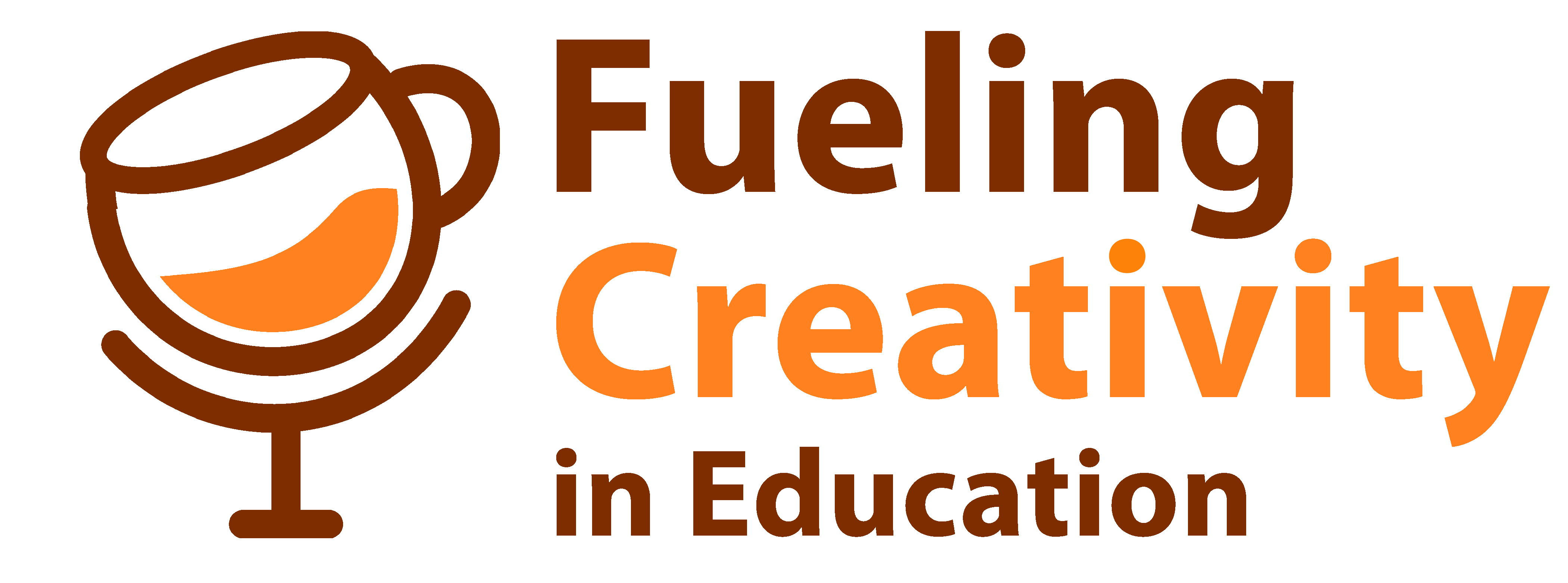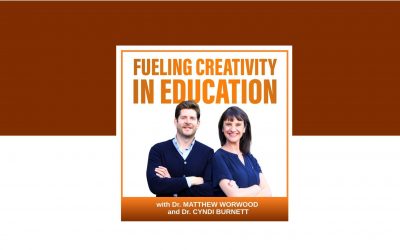LISTEN & LEARN
Deeper Thinking in the Classroom: A Conversation with Katie Trowbridge on Teaching Creativity
“ the Deeper Thinking in the Classroom book is all about how to get students to three think in creative critical ways, how to get them to be connected. And it helps educators take what they’re already doing so the curriculum that they’re already working on K through 12 and walk through the create method. ”
– Katie Trowbridge
Episode Transcription
Deeper Thinking in the Classroom: A Conversation with Katie Trowbridge on Teaching Creativity
Cyndi Burnett:
Hello and welcome to the Fueling Creativity and Education podcast.
Matthew Worwood:
It’s summer break here in the US and that means it’s time for another Listen and Learn series.
Cyndi Burnett:
And this series features bite sized episodes designed to support some professional development during the holidays.
Matthew Worwood:
Now, as Scholar practitioners, Cindy and I do see the summer as a chance to recharge and catch up on new ideas and research.
Cyndi Burnett:
So Matt and I put together a list and we reached out to some of our past guests who have recently published books and invited them back to talk briefly about their latest work.
Matthew Worwood:
And if you’re a regular listener to the show and listened to one of our Listen and Learn series before, you’ll know that these off season episodes are short and focused. We asked just three questions about their new book, providing a perfect way to stay inspired while still making time for at rest and family.
Cyndi Burnett:
So whether you’re a new or regular listener, be sure to follow us on your favorite podcast platform and enjoy this special summer edition of Fueling Creativity and Education.
Matthew Worwood:
So let’s begin. Hello and welcome to another episode of our Listen and Learn series for summer 2025. So today we welcome back to the Katie Trowbridge. Katie Trowbridge brings over 20 years of experience in education as a teacher and mentor and has dedicated a career to empowering educators by integrating engagement and deeper thinking strategies into existing curricula and fostering creative classroom environments. She is the driving force behind the Create method. In season seven, she spoke to us about creative and critical thinking in the classroom and today she is here to talk about her book, Deeper Thinking in the Classroom. Katie, welcome to the show. It’s great to have you back.
Katie Trowbridge:
Thank you for having me back.
Cyndi Burnett:
So Katie, we ask all of our guests in this Listen and Learn series the same questions. And so where we would like to start is could you give us a 60 second pitch of your book?
Katie Trowbridge:
You bet. So the Deeper Thinking in the Classroom book is all about how to get students to three think in creative critical ways, how to get them to be connected. And it helps educators take what they’re already doing so the curriculum that they’re already working on K through 12 and walk through the create method. So get them to be curious, help them be risk takers, help them to experience what they are doing in the classroom, work on their attitude, their team building, and then ultimately evaluate their creative critical thinking skills.
Cyndi Burnett:
That was fantastic. What a great pitch. So Katie, can you tell us a little bit about a misconception about your topic that your book really breaks open?
Katie Trowbridge:
Absolutely. I think the number one Misconception is that creativity is something that cannot be measured, that it is something that is not really needed in the classroom, that it’s just a fun add on. And it is just really something that is for the arts. It’s something that the art teacher needs to do, the fine arts teacher needs to do. It doesn’t belong in the math classroom, the science classroom. Really what this book does is it breaks that down, it shows all the myths, it explains what creativity really is. And then it really goes into how the foundation of all that really belongs first with curiosity. So let’s start with your content.
Katie Trowbridge:
What is it that students are curious about? And then building that into creative thinking, critical thinking, risk taking, open mindedness, all of those things can be fit into anything you’re teaching, any grade, any content. So really showing that misconception of oh, creativity, all those things that’s just, that’s for the art teacher. That’s. I just need to get my play DOH out or my markers out or my paint out. No, no, no. It belongs anywhere at any time. You can work it in to anything you’re doing. It’s not this add on.
Cyndi Burnett:
Matt, you know what this reminds me of as well is what a great compliment this would be to our other Listen Learn series book by Anna Abraham around myths of creativity and creativity in the brain. So I think this is a great complement to one another because the one is really focused on the research. And Katie’s book really is packed full of lots of strategies that teachers can use.
Katie Trowbridge:
Yes. And that absolutely. And I love her book by the way. But that’s what this, what was key for me when I was creating this book is that there is research in this, but this walks you through. It is very much like a workbook where it is asking you questions. It has a lot of strategies in there so that it has do this next. Think about this next. What if you tried this so that an educator really goes step by step so that it isn’t just a walk you through the philosophy, but it is very practical.
Cyndi Burnett:
And you have a companion book that goes with it as well.
Katie Trowbridge:
I do, yes, I do. Because the companion book, the Deeper Thinking book really walks you through the classroom setting. The companion book is also for personal because it’s important that teachers also believe that they are creative. And so the companion book goes into even more of the strategies, but also personally and professionally. How can teachers bring creativity, critical thinking, connection into their own lives?
Matthew Worwood:
And I just want to go back to something you said in your first response as well, because that’s been something we’ve been talking about a little bit around Metacognition is that it sounds. You talk about measuring for creativity, but in your first response, you were talking about how students, you know, the Create method is teaching teachers how to facilitate that perhaps metacognitive approach to creativity when they’re thinking about, you know, am I thinking critically about this information and how creative is it, and how am I evaluating and measuring that creativity? Is that. Is that a fair assessment in terms of the measuring piece? It’s not just. It’s about. We get to measure. We teach students how to measure their own creativity as well.
Katie Trowbridge:
Right. So part of that is the teacher’s role in the evaluation, but the student’s role in the evaluation too. So reflection. Right. Peer to peer evaluation. So a lot of that is in the E. The last E in the Create method. Because I think a lot of what I hear is, oh, that’s nice, Katie.
Katie Trowbridge:
But you can’t really measure it. And education is so full of data collection, but you can’t. I mean, look at the PISA test that just came out. Right. The PISA report where we can measure creative thinking, and we can do that, but it’s also important that we take time as students to reflect on it. How am I growing in my creative thinking? How am I being able to evaluate my own take on things, my process in my thinking? Right. So thinking of the metacognition, thinking about my own thinking, so that it’s not just looking at my educator, my teacher, and saying, how did I do? But me thinking, how did I do? Right. Personally, and then being able to look at my peers and giving that kind of feedback as well.
Katie Trowbridge:
So that’s all vital. And we go through that in the book.
Matthew Worwood:
And I’m going to actually make a connection to another book we’ve had as well, which is from Serana, who wrote the Creativity Choice. And it sounds to me as well that there’s an opportunity to, you know, there’s sometimes even I, you know, sometimes I probably choose not to be creative. Sometimes it’s easier just to kind of like, select the first idea that comes. It satisfies the problem, and you’re able to quickly move on. But as Sarana was talking a lot in her episodes, creativity is a choice that we make, and it’s a choice to go and sometimes explore the less trodden path and pursue originality and try things that are different and be kind of like, receptive to the fact that it might fail. And there’s a lot of different things that we have to deal with and navigate as we make that decision. But it sounds to me that you’re giving students an opportunity to make that choice or at least be able to reflect on whether or not they chose to be creative or not.
Katie Trowbridge:
Correct? Yes. And choices. We talk about choice quite a bit in the book. We talk about productive struggle in the book, which is that same kind of thing, right. Going through the struggle of making those choices. Sometimes it’s the easy way out. Why do you want to fail? How important it is to fail in the process of being creative, all of that. We talk about that in the book.
Katie Trowbridge:
We’ve got to be able to allow students the opportunity to fail. And as teachers and as parents, and that can be very difficult to watch our young people fail. But we have to allow them to do that. We have to allow them to struggle. We have to give them the choice and the opportunity to do that, to know that we’re there. Right. It’s like when you were teaching them how to ride a bike. You got to let go, you got to watch them fail, you got to watch them fall.
Katie Trowbridge:
But we got to encourage them to get right back up. And so we talk about that in this book quite a bit. That create method, allowing them to do that and then cheering them on, celebrating that, woohoo, you failed. Right. But then how do we help them then evaluate that, reflect on that. Now what do we do? And so that’s why it was so important to me when we wrote this book that we really made sure there were practical, relevant, meaningful steps. And as an educator, to me, that was so important. It was great to read books that gave me the here’s what you should be doing.
Katie Trowbridge:
But then I would always be left with, okay, so how. And that was what was so important to me when writing this book, is that there was plenty of the how.
Cyndi Burnett:
So, Katie, we ask one last question, but I’m going to actually, I want to narrow this question down a little bit because this is a question we often get in working with educators. So the question is, what is one concrete or practical thing your book can teach others? But here’s what I really want you to focus in on is that evaluate piece of. So you’ve got students in the classroom you mentioned earlier, like you can measure creativity in the classroom. So what is a practical or concrete way that you would recommend educators to measure creativity in the classroom?
Katie Trowbridge:
So rubrics are huge, right? We all use rubrics. One of my favorite things to do in the classroom was having students create rubrics together. So instead of me coming up with here is the rubric, here’s how you will be evaluated. It is, here’s how we can be evaluated together. So let’s do this together. Here is the creative product that we are going to be creating. So let’s say we are going to be creating a podcast or we’re going to be creating a blog and going back to what Matt was saying about giving choice. Maybe we are going to be creating multiple things, but what is it that we are going to be evaluated on? And let’s have the students come together to help us evaluate that instead of me dictating that there might be certain standards that I have to hit.
Katie Trowbridge:
But let’s have the students be involved in that process of evaluation creation instead of it just coming from me. So we would do that together as a class. And then I would always have a section where they would have their own line of evaluation so that the final thing, especially if, you know, let’s say, Matt, you are doing a podcast. Cindy, you are going to create a blog. Maybe someone is going. Then you would have your own line of evaluation. So then that you would have your own. That rubric was yours.
Katie Trowbridge:
It belonged to you. Now, I would still grade you on that many times. You would evaluate yourself and then I would evaluate you and I would merge those grades. And I will be honest, multiple times. The student was much harder on themselves than I was.
Matthew Worwood:
I like that. I might even explore that in my one of my University of Connecticut classes. So, Katie, it’s been a pleasure having you on the show. We hope you enjoyed this summer 2025 listen and learn episode. Don’t forget, please visit our website, which provides a full list of all the books we’ve covered during this series with links to the author’s websites and links to where you can purchase their books online. You can access this page@foldingcreativitypodcast.com summerreading2025 While.
Cyndi Burnett:
We have all of our guests for season 11 of the podcast, we are now booking for season 12. So if you have any ideas of researchers, practitioners or educators, or perhaps ideas on topics that you’d like us to cover that we haven’t covered yet, please reach out@ideasuelingcreativitypodcast.com My name is Dr. Cindy Burnett.
Matthew Worwood:
And my name is Dr. Matthew Wyrwood.
Cyndi Burnett:
This episode was made possible thanks to our sponsor, Curiosity to.
In this special Listen and Learn episode of the Fueling Creativity in Education Podcast, hosts Dr. Cyndi Burnett and Dr. Matthew Worwood welcome back Katie Trowbridge, an educator with over 20 years of experience and the creator of the CREATE method. Katie discusses her newly released book, Deeper Thinking in the Classroom, which is designed to guide educators in weaving creative and critical thinking strategies into existing K-12 curricula. She emphasizes that creativity is not just for the arts—debunking the myth that it’s a classroom “add-on”—and showcases how curiosity forms the foundation of deeper thinking across all subjects. The CREATE method (Curiosity, Risk-taking, Experience, Attitude, Team building, and Evaluation) provides teachers with practical steps and a clear structure for nurturing student creativity and critical thinking.
Katie also talks about her companion book, aimed at helping teachers recognize and cultivate their own creativity both personally and professionally. The conversation highlights the importance of evaluating creativity in classrooms, not just through traditional rubrics, but by involving students in co-creating assessment criteria, fostering self-reflection, peer evaluation, and metacognitive skills. Practical tips and resources are shared, reinforcing the book’s hands-on approach, and connecting to topics discussed in previous episodes—making this episode a valuable resource for educators seeking to reinvigorate their teaching with strategies for deeper, measurable creative engagement.
About the Guest
Katie Trowbridge has over two decades of experience as a teacher and mentor. She is President and CEO of Curiosity 2 CREATE, a nonprofit organization focused on helping educators incorporate creative and critical thinking strategies into their existing curricula and build creative classroom environments. Katie has won several Teacher of Excellence and Outstanding Educator awards, has a Master’s in Teaching and a Master’s in Education Administration, and is pursuing her ED.D at Northeastern University in Boston.
Episode Debrief
Collection Episodes
Developing Talent for Activism: Transformational Giftedness and Animal Justice
Listen & Learn Developing Talent for Activism: Transformational Giftedness and Animal Justice“Instead of telling somebody, here's what you need to believe about animals, She gives him information about animals, Here's what study show about how animals behave, and...
Just a Banana and The Rabbit’s Feat: A Conversation with Children’s Book Author Barney Saltzberg
LISTEN & LEARN Just a Banana and The Rabbit’s Feat: A Conversation with Children's Book Author Barney Saltzberg“ And then I came up with an idea called Imagine Art. And it was finding art in cracks in the sidewalk, peeled paint, things like that. And when I was...
Meet Their Needs, and They’ll Succeed: A Conversation with Principal El
LISTEN & LEARN SERIES Meet Their Needs, and They’ll Succeed: A Conversation with Principal ElAnd I said to myself, what if every child, every kid had someone like that, someone who was like a nurse that made them feel like nobody else mattered, you know, but them,...
Podcast Sponsor

We are thrilled to partner with Curiosity 2 Create as our sponsor, a company that shares our commitment to fostering creativity in education. Curiosity 2 Create empowers educators through professional development and community support, helping them integrate interactive, creative thinking approaches into their classrooms. By moving beyond traditional lecture-based methods, they help teachers create dynamic learning environments that enhance student engagement, improve academic performance, and support teacher retention. With a focus on collaborative learning and exploration, Curiosity 2 Create is transforming classrooms into spaces where students thrive through continuous engagement and growth.








